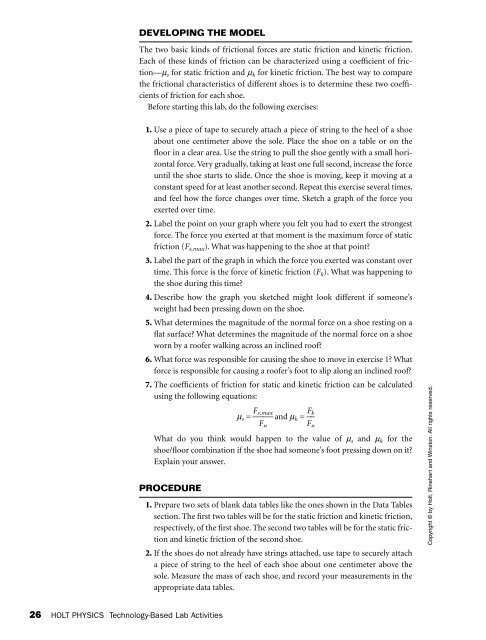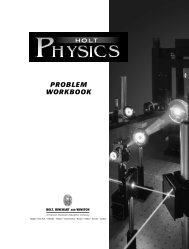TECHNOLOGY-BASED LAB ACTIVITIES
Lab Activities (PE).pdf - langlopress.net
Lab Activities (PE).pdf - langlopress.net
Create successful ePaper yourself
Turn your PDF publications into a flip-book with our unique Google optimized e-Paper software.
DEVELOPING THE MODEL<br />
The two basic kinds of frictional forces are static friction and kinetic friction.<br />
Each of these kinds of friction can be characterized using a coefficient of friction—m<br />
s for static friction and m k for kinetic friction. The best way to compare<br />
the frictional characteristics of different shoes is to determine these two coefficients<br />
of friction for each shoe.<br />
Before starting this lab, do the following exercises:<br />
1. Use a piece of tape to securely attach a piece of string to the heel of a shoe<br />
about one centimeter above the sole. Place the shoe on a table or on the<br />
floor in a clear area. Use the string to pull the shoe gently with a small horizontal<br />
force. Very gradually, taking at least one full second, increase the force<br />
until the shoe starts to slide. Once the shoe is moving, keep it moving at a<br />
constant speed for at least another second. Repeat this exercise several times,<br />
and feel how the force changes over time. Sketch a graph of the force you<br />
exerted over time.<br />
2. Label the point on your graph where you felt you had to exert the strongest<br />
force. The force you exerted at that moment is the maximum force of static<br />
friction (F s,max ). What was happening to the shoe at that point?<br />
3. Label the part of the graph in which the force you exerted was constant over<br />
time. This force is the force of kinetic friction (F k ). What was happening to<br />
the shoe during this time?<br />
4. Describe how the graph you sketched might look different if someone’s<br />
weight had been pressing down on the shoe.<br />
5. What determines the magnitude of the normal force on a shoe resting on a<br />
flat surface? What determines the magnitude of the normal force on a shoe<br />
worn by a roofer walking across an inclined roof?<br />
6. What force was responsible for causing the shoe to move in exercise 1? What<br />
force is responsible for causing a roofer’s foot to slip along an inclined roof?<br />
7. The coefficients of friction for static and kinetic friction can be calculated<br />
using the following equations:<br />
m s = ⎯ F s,max<br />
Fk<br />
⎯ and m k = ⎯<br />
F<br />
F<br />
n<br />
What do you think would happen to the value of m s and m k for the<br />
shoe/floor combination if the shoe had someone’s foot pressing down on it?<br />
Explain your answer.<br />
PROCEDURE<br />
1. Prepare two sets of blank data tables like the ones shown in the Data Tables<br />
section. The first two tables will be for the static friction and kinetic friction,<br />
respectively, of the first shoe. The second two tables will be for the static friction<br />
and kinetic friction of the second shoe.<br />
2. If the shoes do not already have strings attached, use tape to securely attach<br />
a piece of string to the heel of each shoe about one centimeter above the<br />
sole. Measure the mass of each shoe, and record your measurements in the<br />
appropriate data tables.<br />
n<br />
Copyright © by Holt, Rinehart and Winston. All rights reserved.<br />
26 HOLT PHYSICS Technology-Based Lab Activities





